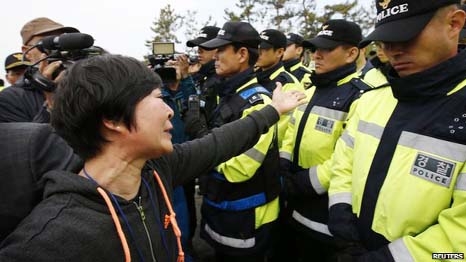
BBC Online :
Families of passengers on a sunken South Korean ferry have protested angrily over the rescue operation.
Police stopped up to 100 people trying to leave Jindo island intending to march to the country’s capital, Seoul.
After more than three days, divers have now finally entered the ferry, retrieving 22 bodies and bringing the death toll to 54.
However, another 248 people are still missing from the Sewol ferry, which sank on Wednesday.
There was grief, anger and desperation as dozens of relatives tried to push through a massive police cordon. They said they wanted to march to the capital and occupy the presidential house. It was a purely symbolic act as Seoul is a five-hour drive away but yet another example of the frustrations of the relatives. Many parents of the missing students accept that their children are not coming back.
Down at the port, boats are bringing more bodies ashore. Families are being taken to a temporary morgue to identify the corpses. I heard one woman sobbing loudly from inside.
With more than 200 bodies still trapped inside the ferry, this recovery operation will last for several days.
The families still waiting are now calling for the operation to be speeded up.
Since the capsize, many of the relatives of those on board have been on Jindo, in the south-west of the country.
Hundreds have been camping at a gymnasium on the island, awaiting news from the rescue operation.
Scuffles broke out when some family members tried to cross a bridge to the mainland, reportedly to march on the Presidential Blue House in Seoul, some 420km (260 miles) to the north.
“Bring me the body so that I can see the face and hug my child,” shouted one woman.
Lee Woon-geun, father of missing passenger Lee Jung-in, 17, said: “We want an answer from the person in charge about why orders are not going through and nothing is being done. They are clearly lying and kicking the responsibility to others.”
Relatives are anxious for the bodies to be retrieved before they decompose.
The BBC’s Jonathan Head on Jindo says even the prime minister came down to try to dissuade the protesters from marching on Seoul, with officials worried that the controversy could turn into a national political issue and harm the government.
Boats carrying 13 of the recently retrieved bodies arrived at Paengmok Port on Jindo on Sunday.
Graphic showing location of sunken ferry and timeline of events About 200 ships, 34 aircraft and 600 divers have been taking part in the search operation, our correspondent says.
Squid fishing boats with powerful lights have been brought in to help the divers operate at night.
But the currents are still strong and the visibility remains challenging.
Coastguard official Koh Myung-seok told a briefing that divers had discovered a number of routes into the ferry, and found bodies in different locations.
The captain and two other crew members are in custody and have been charged with negligence of duty and violation of maritime law.
Officials said on Saturday that the ferry was being steered by an inexperienced third mate in unfamiliar waters when it sank.
The captain of the ferry, 69-year-old Lee Joon-seok, was not initially on the bridge when the ship ran into trouble.
The Sewol, carrying 476 passengers and crew, capsized during a journey from the port of Incheon in the north-west to the southern holiday island of Jeju.
Investigations are focusing on a sharp turn the vessel took before it started listing and whether an evacuation order could have saved lives.
Some experts believe the ship’s tight turn could have dislodged heavy cargo and destabilised the vessel, while others suggest the sinking could have been caused by a collision with a rock.

